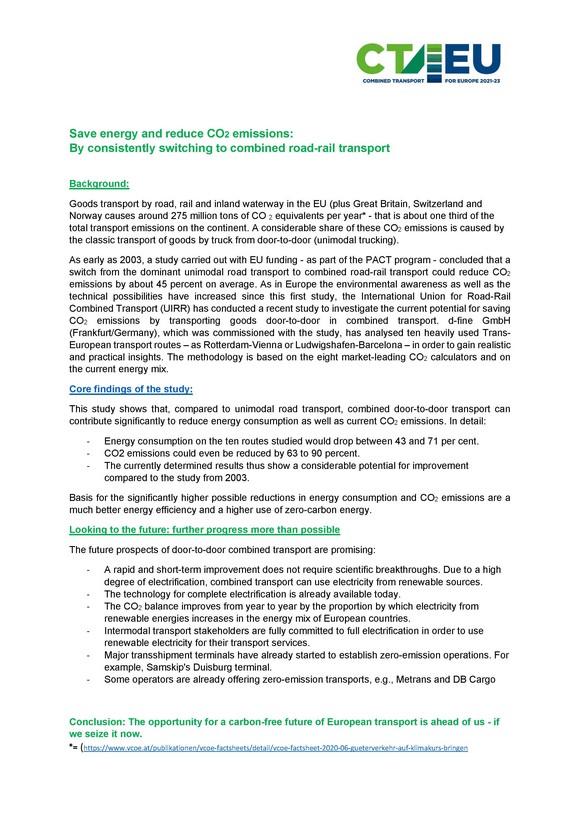Press Release April 2022
Press release
Door-to-door combined transport can reduce CO2 emissions of the freight transport sector by up to 90 percent
Brussels. By switching from the presently dominant unimodal truck transport to door-to-door combined transport, CO2 emissions of inland freight transportation in the EU could be reduced by up to 90 percent. At the same time, energy consumption for these door-to-door transport services could be reduced by up to 71 percent.
This is the conclusion of a recent study by the European consulting company d-fine GmbH. The consultancy was commissioned by the International Union for Road-Rail Combined Transport (UIRR) to analyse ten heavily used trans-European transport routes – such as Rotterdam-Vienna or Ludwigshafen-Barcelona – in order to gain realistic and practical insights. The result of the extensive study shows that door-to-door combined transport has the potential to significantly reduce energy consumption compared to unimodal road transport, while at the same time significantly decrease the still high CO2 emissions. UIRR President Ralf-Charley Schultze: "The opportunity for a carbon-free future of European transport is right in front of us. Here, door-to-door combined transport can already play a key role in reducing CO2 emissions in the inland freight transport sector."
The current study done for UIRR shows significant improvement compared to a previous study from 2003. At that time, a study carried out with EU funding within the framework of the PACT program concluded that a switch from truck transport to road-rail combined transport could reduce CO2 emissions by about 55 percent on average. The main reason for the currently significantly higher possible CO2 savings is two effects: higher energy efficiency and better use of carbon-free energy. In the meanwhile the energy saving potential of combined transport grew from 29% to a maximum 71% with the shortest road legs.
The future prospects of door-to-door combined transport are also promising, as combined transport can directly use electricity from renewable sources. Moreover, the technology for electrification of the entire door-to-door intermodal transport-chain is already available. This means that the CO2 balance improves from year to year in proportion to the degree with which electricity from renewable sources increases within the energy mix of European countries.
Practical evidence shows that more and more intermodal transport stakeholders are committed to full electrification in order to use renewable electricity for their transport services. Operators such as Metrans and DB Cargo are already offering zero-emission transports. In addition, major transhipment terminals, such as Samskip's Duisburg terminal or CFL’s Bettembourg terminal, have started to set up zero- emission operations.
"The ultimate target is to make door-to-door combined transport part of every Member State's effort towards carbon neutrality," emphasises UIRR President Ralf-Charley Schultze. "Let's make it happen!"
For further information please contact:
Akos Ersek, E-mail: aersek@uirr.com, Tel. : +32 (0)2 548 78 91
Click on the image to download the CT4EU One pager

The International Union for Road-Rail Combined Transport (UIRR) represents the interests of European road-rail Combined Transport Operators and Transhipment Terminal Managers.
Road-Rail Combined Transport (CT) is a system of freight forwarding which is based on efficiently and economically inserting electric rail into long-distance (road) transport chains through the use of intermodal loading units (ILU). www.uirr.com - www.ilu-code.eu/en/